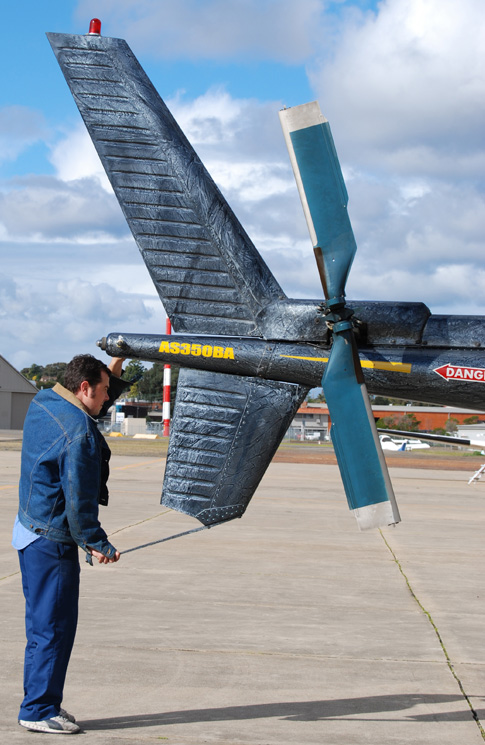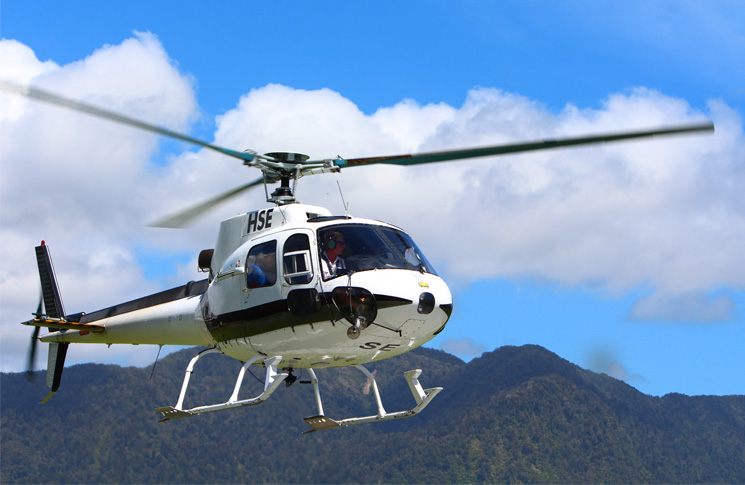If your helicopter starts spinning you will need to analyse, decide and act-quickly, Brendan Reinhardt writes.
Even in the simulator a fully developed yaw control emergency is horrifying. It announces its arrival with a shudder and a mechanical groan, followed almost immediately by a babel of synthetic voices crying out a range of problems. The whole event is over, for better or worse, in a few seconds. The simulator makes it clear that you have only two defences—prevention and preparation.
Among the most important forms of prevention is to keep control of loose items in the helicopter, as two recent incidents show.
In the first incident a Canadian powerline inspection AS350 helicopter stored a bag of tools on an external platform. The bag was normally attached to the platform by a carabiner however the bag and carabiner blew off the platform and struck the tail rotor. The helicopter shortly departed controlled flight killing all four occupants. Initial investigation found the tip of a tail rotor blade 600m away from the crash site with a damaged tool bag and carabiner.
In the second incident the interim report says there was evidence that a pair of trousers came out of the cabin and became tangled in the tail rotor of a Hughes 369 helicopter in New Zealand. Paint marks on the trousers were similar to the paint on the tail rotor and marks on the tail rotor matched the trousers’ zipper. The tail section was reported as being more than 100 metres away from the wreckage. All three occupants received fatal injuries. The helicopter had a recent history of doors becoming insecure in flight.
The issue here is foreign object control/damage (FOC/FOD). Both Canada and New Zealand issued guidance on securing loads. The Robinson Helicopter Company also has a video outlining a safety notice on FOD and tail rotors.
Preparation is also important, but has its limits. Yaw control emergencies (YCE) are complicated to understand and respond to. They require significant pre-thought and practice (preferably in a simulator). This discussion will not consider the separation of the tail rotor from the aircraft as this is not normally recoverable. (This is because loss of the tail rotor and gearbox adds a large and sudden change in centre of gravity to the YCE.) For other YCE, the main failure mechanisms can be grouped into:
- Total loss – due to a drive shaft failure where the tail rotor stops spinning
- Fixed pitch – insufficient or excessive pitch of the tail rotor due to some sort of jam in the control run
- Loss of pitch control – due to a breakage in the control run

In the hover a total loss will result in rapid rotation opposite to the direction the blades rotate. In helicopters where the throttle controls are on the collective closing the throttle will remove the torque, reduce the rate of spin and allow the pilot to attempt a hover autorotation. In larger aircraft the throttle controls cannot easily be brought to idle or off as they may not be located on the collective. If there is a copilot then they can reduce the engines to idle or off. Loss of pitch control will require a similar response as the blades fine off providing almost the same amount of thrust as a total loss. The fixed pitch condition should be identified as the helicopter is lifting off by gently checking that you have appropriate control response before committing too far into the hover. You may also find yourself with a stuck pedal after conducting a pedal turn as this is when the controls may come up against a jam. In either case you will normally end up in a slow turn to the left or right. If it is excessive thrust then as you lower collective the rate of yaw will increase. If it is insufficient thrust then as you lower collective the rate of yaw will decrease. Lowering the collective to put the aircraft back on the ground is often the best course of action. The aim is to land the helicopter with minimal drift whilst slowly turning so you don’t roll over when a skid or wheel catches on an uneven surface. There are various techniques that can be used with collective mounted throttles to change the amount of torque being produced by the tail rotor however care needs to be taken to ensure that main rotor RPM limits are not exceeded (insufficient) nor the tail rotor RPM reduced so far that the tail rotor loses all effectiveness (excessive) and you end up spinning in the opposite direction to the original condition. Consult your helicopter flight manual and company operations manual for guidance on throttle manipulation.
Hovering out of ground effect (OGE) complicates the emergency. With a total loss there is little choice but to remove the engine torque and autorotate as best as possible. It may be better to commit to a heavy autorotational landing utilising the undercarriage to absorb the descent than end up having a spinning flying accident at some forward speed. However, if the situation is a stuck pedal and you are in a high OGE hover then you may find you can fly away (all be it a fair bit out of balance) by trading height for speed and then ending up with a forward flight YCE condition which may be easier to deal with.
In forward flight we have the advantage of the tailboom and fin working to help keep the aircraft roughly straight and the greater the airspeed the more they help. In the case of a total loss of tail rotor thrust the collective may to be able to be lowered to maintain directional control and entry into autorotation may not be necessary immediately. The reduced power may mean the helicopter has to descend to maintain sufficient airspeed to keep the tailboom and fin creating enough force to keep roughly pointing straight. There will be a lot of out of balance flight. Sufficient collective may be able to be maintained to allow flight to a more suitable autorotational area as well as roughly steer the helicopter. In a US helicopter (blade rotation anti clockwise when viewed from above) raising the collective will turn the nose right and lowering the collective will turn the nose left. RAISE RIGHT LOWER LEFT. In a French helicopter (blade rotation clockwise when viewed from above) lifting the collective will turn the nose left and reducing the collective will turn the nose right. LIFT LEFT REDUCE RIGHT. Ultimately however for a total loss an entry into autorotation is required to conduct the landing.
Fixed pitch YCE will require an assessment. It may be able to be determined whether it is excessive or insufficient from direct observation of the pedal position compared to when the helicopter was hovering or noting what you were doing at the time it became fixed (ie climbing = excessive, descending = insufficient). A flying analysis can also be conducted where the aircraft is slowed progressively (5-10 KIAS increments) at a safe altitude to the point where the helicopter is level and flying a straight ground track whilst the nose is either pointing straight or out to the excessive side (left for US, right for French). The upper air analysis is normally conducted down to around the bucket or endurance speed where the power required is around a minimum. This will depend on how effective the tailboom and fin are. At this point the skid ball is assessed to determine whether the aircraft is way out of balance, out of balance or only a little out of balance. With lower power set this then tells us whether we have excessive – way out of balance, insufficient – a little out of balance or somewhere in between. Armed with this knowledge we can estimate the likely type of arrival that will be conducted. If at any time during this assessment the nose swings past straight to the insufficient side (right for US, left for French) then the collective will have to be lowered and the helicopter accelerated to regain control. If during the assessment the nose is out past straight to the insufficient side (right for US, left for French) above the bucket or endurance speed then an autorotative landing will be required.
For excessive, the helicopter can be brought to a hover with a slow rotation in the same direction as the main rotor. For in between the aircraft may be able to be brought to a hover without any turning. For insufficient the helicopter will be run on at a speed where the nose is straight or if this speed is too great then a steep descent will be conducted and in the flare the throttles will be closed for an autorotational landing. In this case it may be better to conduct a slower speed autorotational landing than attempt a high speed run on landing.
If a run on landing is to be attempted the helicopter is now positioned on a long low final and the aircraft speed progressively decelerate in 5–10 KIAS increments. At each stage the helicopter is levelled and the nose direction assessed. As the helicopter decelerates more torque is produced and less force from the tailboom and fin is generated. This means that eventually the aircraft will end up at a given speed pointing straight as the torque balances the tailboom and fin force. Positioning any crosswind to help the tailboom and fin may allow slower ground speeds to be achieved (from the right for US, left for French). It is at this balanced point that the aircraft can be either run onto the landing surface or brought to a hover with or without a slight rotation towards the excessive side. Some smaller single engine helicopters have a collective mounted throttle or beep switch that can allow slight manipulation to reduce the excessive tail rotor thrust. However, ensure that you don’t reduce tail rotor thrust to the point where it can no longer oppose the torque of the main rotor or you move the engine governor out of the governed range. In the case of an aircraft without collective throttles and a run on landing is being conducted the aircraft is run on straight and when all undercarriage surfaces are on the ground the engines can be turned off. Once on the ground use cyclic and differential braking as best as possible to keep the helicopter tracking straight.
For the autorotational steep descent landing the collective is lowered so that the aircraft is pointing roughly straight in a steep descent. Before or in the flare the engine throttles are closed or turned off and an autorotational landing conducted. Carrying a small amount of heading to the insufficient side can be used so that as the collective is raised to cushion the helicopter the nose is straightened. With collective mounted throttles timing when they are closed during the flare can be used to finesse the heading. This requires practice and coordination and may only be useful on single engine helicopters with collective mounted throttles.



Comments are closed.